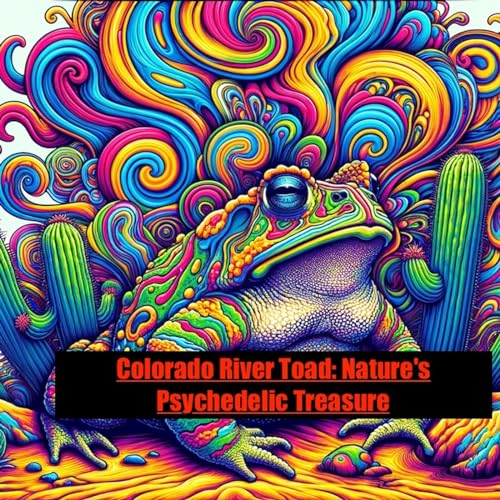-
Colorado River Toad: Nature's Psychedelic Treasure
- 著者: Quiet.Please
- ポッドキャスト
カートのアイテムが多すぎます
ご購入は五十タイトルがカートに入っている場合のみです。
カートに追加できませんでした。
しばらく経ってから再度お試しください。
ウィッシュリストに追加できませんでした。
しばらく経ってから再度お試しください。
ほしい物リストの削除に失敗しました。
しばらく経ってから再度お試しください。
ポッドキャストのフォローに失敗しました
ポッドキャストのフォロー解除に失敗しました
-
サマリー
あらすじ・解説
In the vast, sun-scorched expanses of the Sonoran Desert, a remarkable creature emerges from the shadows of the night. The Colorado River Toad, also known as the Sonoran Desert Toad, is an amphibian that has captured the imagination of humans for centuries. With its striking appearance and unique adaptations, this toad is a true wonder of the natural world. As we delve into the life and times of this fascinating creature, we must first understand its place in the grand tapestry of the desert ecosystem. The Colorado River Toad, scientifically known as Bufo alvarius or Incilius alvarius, is a native of the southwestern United States and northern Mexico. It is a creature that has evolved to thrive in the harsh, unforgiving conditions of the arid and semi-arid regions it calls home. These magnificent amphibians are not small by any means. Adults can reach an impressive length of up to 7.5 inches, making them one of the largest toad species in North America. Their skin is a masterpiece of natural design, smooth and adorned with hues of olive green or brown, allowing them to blend seamlessly into their surroundings. But perhaps the most striking feature of these toads is the presence of large parotoid glands behind their eyes. These glands hold a secret that has both intrigued and troubled humans for generations. During the scorching heat of the day, the Colorado River Toad seeks shelter from the unrelenting sun. They are masters of adaptation, burrowing into the cool earth or finding respite under the shade of rocks and vegetation. But as the sun sets and the night cools, these nocturnal creatures emerge to embark on their nightly adventures. Under the cover of darkness, the Colorado River Toad sets out to hunt. Their keen senses guide them to a variety of prey, from the tiniest of insects to small mammals and even other toads. They are opportunistic feeders, taking advantage of whatever sustenance the desert offers. This ability to adapt and find nourishment in a seemingly barren landscape is a testament to their resilience and evolutionary prowess. As the monsoon season arrives, the desert comes alive with the sounds of life. The male Colorado River Toads join in the chorus, their distinctive trills echoing through the night air. This is the time of courtship and reproduction, a crucial moment in the life cycle of these remarkable amphibians. The females, heavy with eggs, seek out suitable water sources to lay their precious cargo. In a single spawning event, a female can release thousands of eggs, each holding the promise of new life. The tadpoles that emerge from these eggs face a race against time. They must develop and metamorphose into adult toads before the ephemeral desert pools dry up. It is a struggle for survival, but those that make it through this gauntlet are well-equipped to face the challenges of their desert home. The Colorado River Toad's life span is an impressive one, with individuals often living up to 10-15 years in the wild, a remarkable feat for an amphibian in such an unforgiving environment. But there is another aspect of the Colorado River Toad that has garnered attention and controversy in recent years. Within the toad's skin, specifically in the parotoid glands, lies a potent toxin that contains a psychoactive compound known as 5-MeO-DMT. This substance, when extracted and consumed by humans, can induce intense, short-lived psychedelic experiences, characterized by vivid visuals, euphoria, and altered states of consciousness. The use of Colorado River Toad venom for its psychoactive properties has become a topic of great debate and concern. Some individuals seek out the venom for its alleged therapeutic benefits, claiming that it can provide profound spiritual and mystical experiences. They argue that the venom holds potential for treating mental health conditions such as depression and post-traumatic stress disorder. However, the practice of harvesting venom from these toads raises significant ethical and environmental red flags. The overexploitation of Colorado River Toads for their venom can have devastating consequences on their populations. The mere act of handling these toads can cause them immense stress and put their lives at risk. It is a delicate balance between the desire to explore the potential benefits of this substance and the imperative to protect and preserve the very creatures that produce it. The Colorado River Toad's venom is not to be trifled with. It is a highly toxic substance that can have severe health consequences if used improperly. The risks associated with consuming toad venom include seizures, respiratory issues, and even death. The legal status of extracting and using toad venom varies across different jurisdictions, with many places considering it illegal due to the potential for abuse and the threat it poses to toad populations. As we grapple with the complex issues surrounding the Colorado River Toad and its venom, we must not lose sight of the...
copyright 2024 Quietr.Please
エピソード
-
 9 分
9 分カートのアイテムが多すぎます
ご購入は五十タイトルがカートに入っている場合のみです。カートに追加できませんでした。
しばらく経ってから再度お試しください。ウィッシュリストに追加できませんでした。
しばらく経ってから再度お試しください。ほしい物リストの削除に失敗しました。
しばらく経ってから再度お試しください。ポッドキャストのフォローに失敗しました
ポッドキャストのフォロー解除に失敗しました


